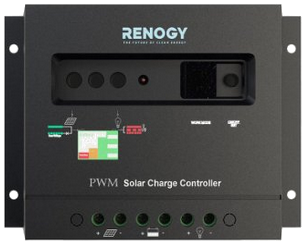

A charge controller, charge regulator or battery regulator limits the rate at which electric current is added to or drawn down from electric batteries. It prevents overcharging and may protect against overvoltage, which can reduce battery performance and lifespan, and may pose a safety risk.
The charge controller is what baby-sits your batteries so you do not have to be present, with test equipment, to disconnect your batteries from your photovoltaic panels once the former have been adequately charged (nor later when you've drawn the batteries down using up the stored electricity).
Most 12-Volt photovoltaic panels actually deliver anywhere from 16 to 20 Volts. The charge controller keeps that output from damaging your 12-Volt batteries. Most 12-Volt batteries only want in the neighborhood of 14 to 14.5 Volts to get fully charged. Back in the day when cars had meters on the dash for their electrical systems, you often saw this voltage when racing the engine or crusing at normal speeds. Your car has a voltage regulatore that protects the batteries from too high a voltage also.

Because equipment is imperfect and environmental conditions like amount of sunlight, the ambient temperature, the temperature of the panel itself on a hot, sunlit day (panels work best at cooler temperatures), etc. are ever changing, panels provide extra voltage to compensate for when conditions are adverse. So a panels voltage rating is typically the minimum it produces until sunlight begins to disappear and night comes.
This is an electronic DC to DC converter that optimizes the match between a photovoltaic array (panel) and your battery bank. In short, such a controller/regulator converts the usually higher voltage output of a solar panel down to (or sometimes up to) the right level wanted by your batteries.
What does the "tracking" semantic of the name mean?
The controller "tracks" electronically the output of your panels and figures out, in an electronic circuit, what the best voltage it can deliver to the batteries to get the maximum amount of electrical current (measured in Amperes) into the battery, which doesn't always mean the highest voltage.
MPPT controllers are best for cooler solar-cell temperatures. They harvest substanitally more power when solar-cell temperatures drop below 45° Celsius. (Remember, this isn't the temperature of the summer air on the roof, but of the essentially black photovoltaic cell itself which gets much hotter.
MPPT charge converters are sophisticated and correspondingly more expensive than...
Both types of controllers adjust charging rates depending on the battery's charge level allowing charging closer to the battery's maximum total capacity as well as monitoring to prevent over-heating.
PWM controllers work best when the solar-cell temperature is moderately high, upwards of 45° to 75° Celsius. PWM controllers are less expensive and incurr less expensive cabling costs. If cables are very long, an MPPT controller should be resorted to. If the total array begins to exceed a few hundred Watts, an MPPT is better too.
See Wiring components.